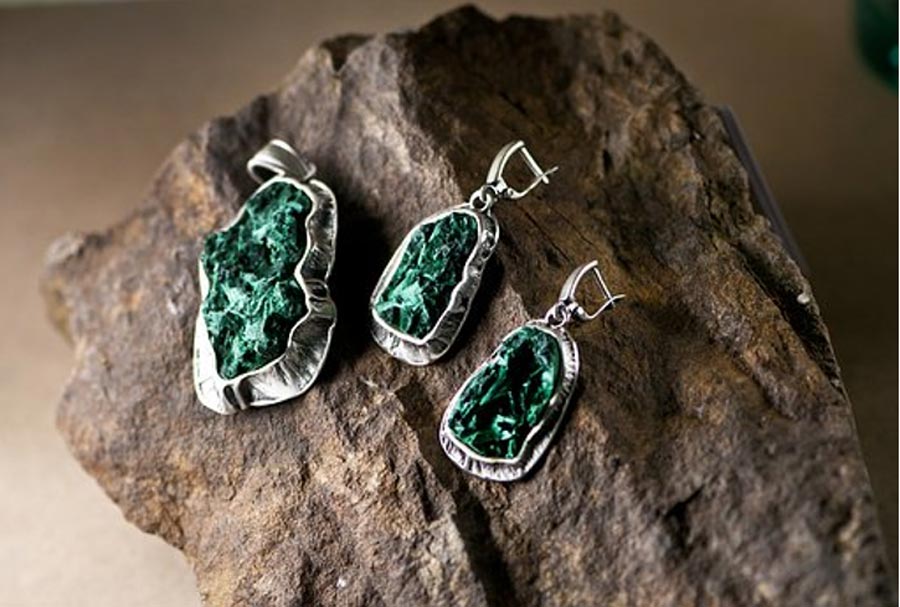Ancient Crystals and Gemstones in Culture and Myth: Magical Malachite
Crystals and gemstones have been a part of ancient cultures for millennia. They were and continue to be used as decoration and to preserve the memories of those who have passed on. Malachite is one such stone that was treasured in civilizations from Egypt to China because it could be carved into beautiful ornaments, used for paint pigments, ground into powder for medicinal purposes, and bring luck and calm.
What is Malachite?
Malachite is a beautiful green mineral found worldwide used in jewelry and other decorative objects. This gemstone is made up of copper and carbonate hydroxide, making it one of many minerals called "carbonates" with a chemical composition of Cu2CO3(OH)2. It is relatively soft with a Mohs hardness between 3.5 and 4.0 and highly sensitive to heat. The stone usually forms in the cracks within limestone rock, leading to its two most common color variations: "banded" and "smooth." Malachite is translucent and opaque, and usually a deep forest green.
The stone can vary in shape from transparent to opaque, with colors ranging from light greens, which are considered rare, to darker shades of green, which you can commonly find around the world. Malachite is often polished into cabochons to be used in necklaces or rings. The most popular color is emerald green, but you can also find this mineral in shades of blue and yellow. The banding pattern of malachite makes it easy to distinguish from other similar types and colors of minerals such as azurite and chrysocolla, which look very similar.
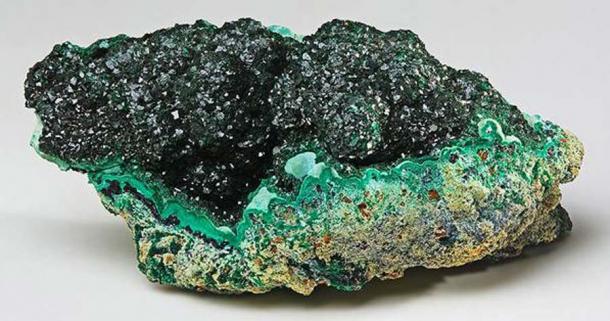
Malachite from the Democratic Republic of the Congo. (JJ Harrison / CC BY-SA 3.0)
How is Malachite Formed?
Malachite is formed when igneous rock and hydrothermal veins are altered in open spaces. Malachite usually forms as a secondary mineral in the oxidation zones of copper deposits. It is often found coating limonite, azurite, or other copper minerals. It also has formed in areas where lead and zinc sulfide ores are present, but it is not common in these environments.
- King of the Ancient Gemstones: Ruby Trumps Diamond
- 3,500-Year-Old Gemstones from Kuwait Shed Light on One of the Oldest Civilizations in the Middle East
As the mineral stone is exposed to heat, pressure, and water over time it forms its unique patterns. . The coloration is due to small amounts of different minerals within the malachite itself.
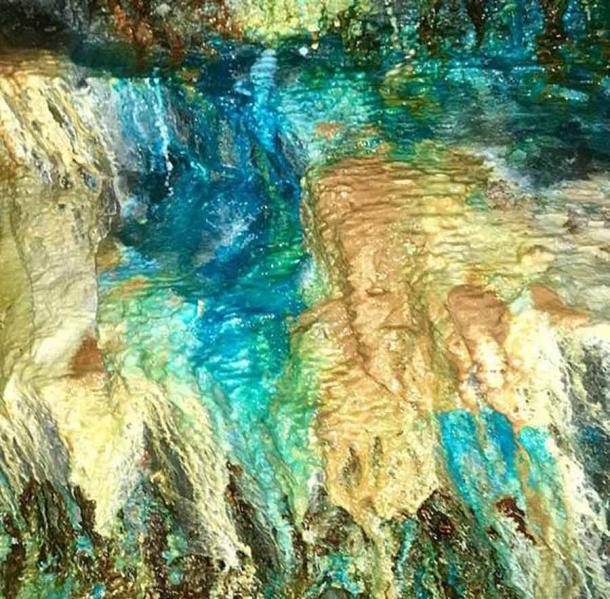
Malachite in the walls of Outokumpu's old mine in Finland. (kallerna / CC BY-SA 4.0)
Where Is Malachite Mined?
Malachite is mined in many different locations around the world. The largest deposits of malachite are found in Russia and in Zambia, where they create beautiful carvings and jewelry pieces.
Other countries with considerable quantities include Australia, Chile, Congo, France, Germany, Greece, Israel, Pakistan, Peru, Poland, South Africa, and the United States. Malachite can also be found near copper mines because it often forms when a chemical reaction takes place between water and other minerals such as chalcopyrite or azurite.
The most common way to extract malachite is by surface mining, which involves removing the overburden with explosives and then using heavy machinery to dig into the ore body.
Malachite can also be mined underground by tunneling into an existing deposit or drilling into a new one. This type of mining is used when the malachite is near the surface, but there isn't enough room to do surface mining. It usually occurs in association with other minerals, such as copper, zinc, lead, and silver.
The Origin of Malachite
Malachite is one of the oldest gemstones that people have used for healing. It was also an important stone in ancient cultures and mythology. The stone gets its name from the Greek word "molochitus," which means "mallow," a leaf with a similar color.
Malachite was first mined over 5000 years ago. Malachite was extensively mined at the Great Orme Mines in Britain 3,800 years ago, using stone and bone tools. The earliest known reference to the stone was in 1400 BC when it appeared on Pharaoh Tutankhamen's tomb wall painting. It gained popularity around 300 BC, when Greek scholars began to write about its existence and properties. That led to the stone becoming popular in Europe and China.
In Egypt, they believed malachite could bring peace to those who wear it so long as the wearer had no hostile intentions towards others. The ancient Greeks believed this stone would protect you from illness if placed under your pillow or wore it at all times with two “Greek” exceptions: during childbirth and when going into battle.
- Lustrous Gems As Amulets And Talismans Of Ancient History
- For 3.3 Million Years Stone and Crystal Traditions Have Shaped Our Destiny
This green mineral has been around for thousands of years and continues to be popular today because of its natural beauty and purported health benefits.
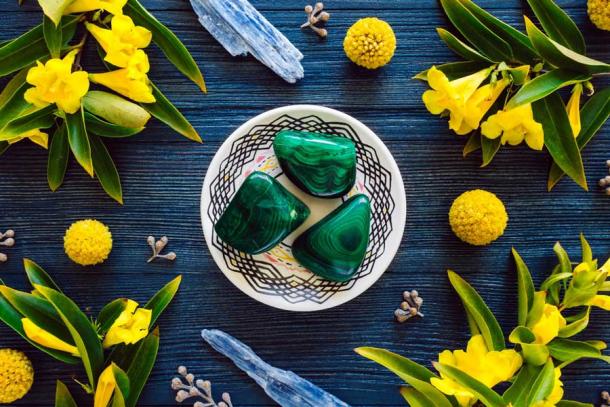
Malachite with blue kyanite and flowering yellow trumpet vine on blue stained wood. (Serena Tayyan / Adobe Stock)
The Pigment, Medicinal and Spiritual Uses of Malachite
Malachite has been known for its healing properties since ancient times. Because of its high copper content, malachite is excellent for making green paints and pigments. It was popular during the Egyptian and Roman empires because they could grind it into powder for paint pigments or makeup. It is still used today for this purpose, despite the more modern and efficient ways to produce green paints and pigments.
Malachite is also frequently used in acupuncture treatment. In traditional Chinese medicine, malachite relieves stomach aches and improves the immune system by stimulating phagocytosis. Bacteria, dead tissue cells, and small mineral particles are all examples of objects that may be phagocytized.
Physically, malachite is known to help with problems such as asthma, bronchitis, fever, and inflammation. Placing a piece of this stone on an afflicted body could heal it or prevent it from worsening.
Malachite is also a protection stone especially during pregnancy and childbirth. It can help ease the transition into motherhood by providing strength and support while helping to protect both the mother and child from negative energy or influences.
Some people add malachite to teas, which they believe can have healing properties if consumed regularly. This practice dates back to ancient Egypt, where the Egyptians brewed up potions made from dried flowers, roots, and crystals during religious ceremonies.
Malachite can also protect against other types of dangers (such as a fire) through its ability to absorb toxic fumes while remaining intact with no damage done. Instead, people prefer this mineral's beauty over its limited properties. Many also believe it can help protect against negative energy when worn regularly by absorbing it and transforming it into positive power.
However, there is no scientific evidence that these practices provide any spiritual benefits such as protecting against negative energy, promoting positive change, stimulating creativity, etc.
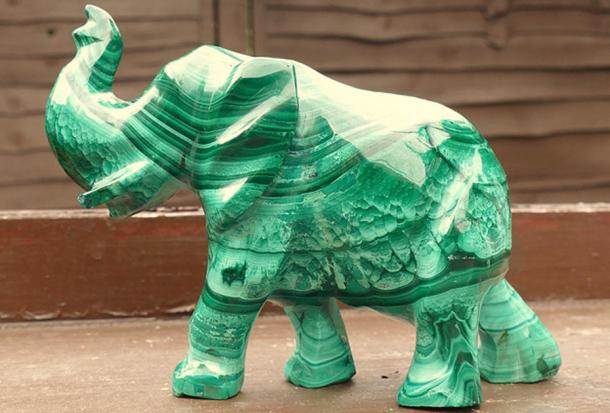
An elephant carved from malachite. (Adrian Pingstone / Public domain)
Malachite is Perfect for Making Objects and Jewelry
Malachite has a long history of being used for decorative objects. It is carved into different shapes and forms, such as animals or flowers, because of its beautiful green color. In Russia, malachite was used to make crosses and other religious objects because it symbolizes resurrection.
On the other hand, in Egypt, malachite was used to make small vases often coated with gold or silver and then decorated with precious stones like lapis lazuli. These tiny containers would contain oils believed to have magical properties, making them valuable because of their rareness.
Today, malachite is still used to create beautiful jewelry pieces or carved into figurines or animals.
Other uses of malachite include:
- Chiseling for jewelry such as rings or bracelets
- Creating decorative objects like vases and plates
- Carving sculptures for gardens to add color and texture
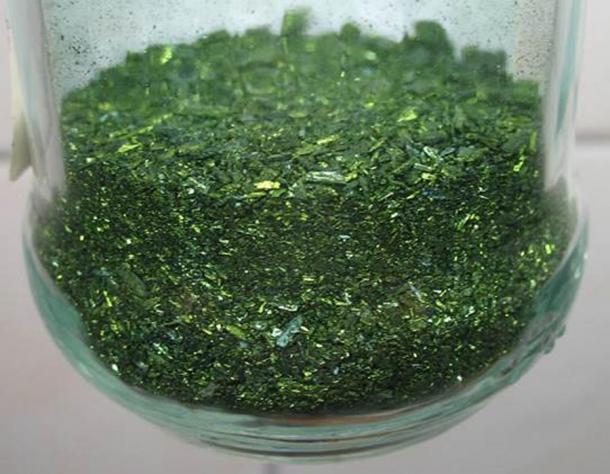
Malachite green oxalate powder contains traces of copper, which is toxic and can be released into the air when malachite is polished or carved. (W. Oelen / CC BY-SA 3.0)
Is Malachite Toxic?
Malachite is a copper carbonate mineral, and as such, it contains traces of copper. When malachite is polished or carved, it can release these copper particles into the air, which can be harmful if breathed in over a long period of time. For this reason, it is essential to wear protective gear when working with this stone.
If the malachite you are using has not been polished or carved, there should be no risk of breathing in copper particles, and thus this stone will likely be safe to handle. Since malachite contains trace amounts of metals like arsenic and lead, children under six and pregnant women should avoid contact with it.
Malachite is a toxic mineral, and you should handle it with care. If ingested, it can cause nausea, vomiting, and diarrhea. It can also irritate the skin and eyes, so it is vital to wash your hands after handling this stone. In Russia, there have been cases where miners have developed malachite poisoning from handling the stone and inhaling its powder.
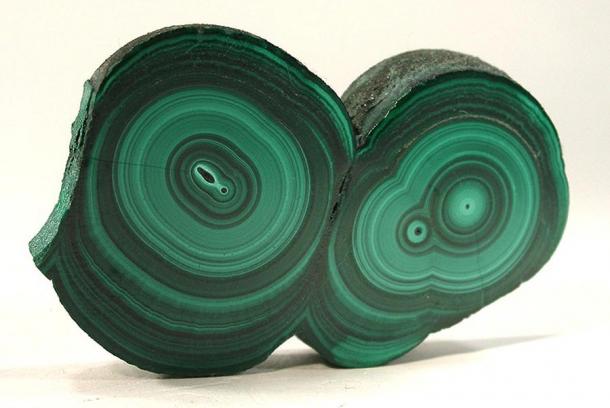
A double stalactite malachite slice from Kolwezi, Democratic Republic of the Congo. (Rob Lavinsky / CC BY-SA 3.0)
The Sacred Properties of Malachite
Malachite is said to have many sacred properties. The stone is said to be able to help you connect with your intuition and better understand your feelings.
It is believed that malachite can help you change situations that are no longer working for you and assist with physical, emotional, and spiritual detoxification. It cleanses the heart and mind, allowing you to let go of negative emotions and attachments that are no longer serving you.
It is a gemstone of balance and connection. It can help you to see the cause-and-effect relationships between your thoughts, words, actions, motivations, and feelings about yourself and others around you. It helps with experiencing life as "unfinished" or not fully expressed. Malachite can help you find and express the missing pieces when this happens.
- World’s Oldest Pearl Found in Abu Dhabi is 8,000-Years-Old!
- Rare Viking Embroidery Found in 1000-Year-Old Grave in Norway
Additionally, it is said to help remove energy blockages, protect against negative energy, and help to calm and soothe the mind. Malachite is also a gemstone of transformation, which means it can help you make changes in your life when you need them most. If you are feeling stuck or like you're not moving forward, malachite may be the suitable stone for you.
In conclusion, malachite is a mineral that cultures have used for centuries. It was often ground up and mixed with oil to create eye shadow and paint pigments. As the use of malachite declined, it became more valued due to its scarcity and beauty. Today, people still wear rings or bracelets made out of this beautiful stone because they believe that wearing it brings luck!
Top image: Malachite silver pendant and earrings. Source: Pixabay
By Arthur Brown
Arthur Brown is a keen writer covering a range of topics including internet marketing, SEO, and more! When not writing, he's found behind his drum kit or taking care of his three kids.
References
Beadnova. 2021. Is Malachite Toxic to Humans? Available at: https://www.beadnova.com/blog/20193/is-malachite-toxic-to-humans
Cohen, J. 2019. 9 Crystals That Increase Focus And Productivity. Available at: https://www.forbes.com/sites/jennifercohen/2019/09/04/9-crystals-that-increase-focus-and-productivity/?sh=124f6ddf5424
Whitney, C. 2021. Malachite Is the Gorgeous Green Gemstone Cleopatra Wore. Available at: https://science.howstuffworks.com/environmental/earth/geology/malachite.htm
















